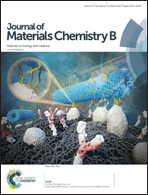Covalent self-assembled nanoparticles with pH-dependent enhanced tumor retention and drug release for improving tumor therapeutic efficiency†
Abstract
Developing a smart drug delivery system with enhanced tumor retention at the tumor site, and rapid intracellular drug release promises to improve the therapeutic index and mitigate side effects. To this end, covalent phenylboronic acid (PBA)-based self-assembly nanoparticles (BNPs) consisting of pH-responsive cores and detachable poloxamer 188 shells were constructed for loading doxorubicin (DOX) in a simple process. The poloxamer 188 coating could be easily detached when the breakage of the borate ester bonds in the external nanocores was initially triggered in the tumor extracellular weak acid environment. The concealed PBA was subsequently exposed and could react with sialic acids (SA), which are overexpressed on tumor cells, and this enhanced the tumor retention effect of the fresh nanoparticle as well as facilitating the cellular uptake after removing the protective layers. Furthermore, owing to the existence of pH-responsive esters, the uptaken fresh nanoparticles could rapidly release DOX in the acidic tumor environment, which resulted in an enhanced therapeutic efficiency in vitro and in vivo. In summary, this pH dependent behaviour of DOX/BNPs provided new insights for enhanced chemotherapeutic treatment in cancer.



 Please wait while we load your content...
Please wait while we load your content...